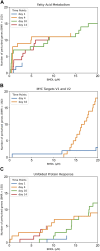A novel method to derive a human safety limit for PFOA by gene expression profiling and modelling
- PMID: 38577564
- PMCID: PMC10991825
- DOI: 10.3389/ftox.2024.1368320
A novel method to derive a human safety limit for PFOA by gene expression profiling and modelling
Abstract
Perfluorooctanoic acid (PFOA) is a persistent environmental contaminant that can accumulate in the human body due to its long half-life. This substance has been associated with liver, pancreatic, testicular and breast cancers, liver steatosis and endocrine disruption. PFOA is a member of a large group of substances also known as "forever chemicals" and the vast majority of substances of this group lack toxicological data that would enable their effective risk assessment in terms of human health hazards. This study aimed to derive a health-based guidance value for PFOA intake (ng/kg BW/day) from in vitro transcriptomics data. To this end, we developed an in silico workflow comprising five components: (i) sourcing in vitro hepatic transcriptomics concentration-response data; (ii) deriving molecular points of departure using BMDExpress3 and performing pathway analysis using gene set enrichment analysis (GSEA) to identify the most sensitive molecular pathways to PFOA exposure; (iii) estimating freely-dissolved PFOA concentrations in vitro using a mass balance model; (iv) estimating in vivo doses by reverse dosimetry using a PBK model for PFOA as part of a quantitative in vitro to in vivo extrapolation (QIVIVE) algorithm; and (v) calculating a tolerable daily intake (TDI) for PFOA. Fourteen percent of interrogated genes exhibited in vitro concentration-response relationships. GSEA pathway enrichment analysis revealed that "fatty acid metabolism" was the most sensitive pathway to PFOA exposure. In vitro free PFOA concentrations were calculated to be 2.9% of the nominal applied concentrations, and these free concentrations were input into the QIVIVE workflow. Exposure doses for a virtual population of 3,000 individuals were estimated, from which a TDI of 0.15 ng/kg BW/day for PFOA was calculated using the benchmark dose modelling software, PROAST. This TDI is comparable to previously published values of 1.16, 0.69, and 0.86 ng/kg BW/day by the European Food Safety Authority. In conclusion, this study demonstrates the combined utility of an "omics"-derived molecular point of departure and in silico QIVIVE workflow for setting health-based guidance values in anticipation of the acceptance of in vitro concentration-response molecular measurements in chemical risk assessment.
Keywords: Bayesian; Markov chain Monte Carlo; NAMs; PBK; PFOA; in silico; omics; reverse dosimetry.
Copyright © 2024 Silva, Loizou, McNally, Osborne, Potter, Gott, Colbourne and Viant.
Conflict of interest statement
The authors declare that the research was conducted in the absence of any commercial or financial relationships that could be construed as a potential conflict of interest. The author(s) declared that they were an editorial board member of Frontiers, at the time of submission. This had no impact on the peer review process and the final decision.
Figures


Similar articles
-
Derivation of a Human In Vivo Benchmark Dose for Perfluorooctanoic Acid From ToxCast In Vitro Concentration-Response Data Using a Computational Workflow for Probabilistic Quantitative In Vitro to In Vivo Extrapolation.Front Pharmacol. 2021 May 11;12:630457. doi: 10.3389/fphar.2021.630457. eCollection 2021. Front Pharmacol. 2021. PMID: 34045957 Free PMC article.
-
Derivation of a Human In Vivo Benchmark Dose for Bisphenol A from ToxCast In Vitro Concentration Response Data Using a Computational Workflow for Probabilistic Quantitative In Vitro to In Vivo Extrapolation.Front Pharmacol. 2022 Feb 11;12:754408. doi: 10.3389/fphar.2021.754408. eCollection 2021. Front Pharmacol. 2022. PMID: 35222005 Free PMC article.
-
Safety and nutritional assessment of GM plants and derived food and feed: the role of animal feeding trials.Food Chem Toxicol. 2008 Mar;46 Suppl 1:S2-70. doi: 10.1016/j.fct.2008.02.008. Epub 2008 Feb 13. Food Chem Toxicol. 2008. PMID: 18328408 Review.
-
Levels of perfluorinated compounds in food and dietary intake of PFOS and PFOA in the Netherlands.J Agric Food Chem. 2011 Jul 13;59(13):7496-505. doi: 10.1021/jf104943p. Epub 2011 Jun 10. J Agric Food Chem. 2011. PMID: 21591675
-
Perfluorooctanoic acid (PFOA), an emerging drinking water contaminant: a critical review of recent literature.Environ Res. 2012 Jul;116:93-117. doi: 10.1016/j.envres.2012.03.007. Epub 2012 May 4. Environ Res. 2012. PMID: 22560884 Review.
References
-
- Alcaraz A. J. G., Baraniuk S., Mikulasek K., Park B., Lane T., Burbridge C., et al. (2022). Comparative analysis of transcriptomic points-of-departure (tpods) and apical responses in embryo-larval fathead minnows exposed to fluoxetine. Environ. Pollut. 295, 118667. 10.1016/j.envpol.2021.118667 - DOI - PubMed
LinkOut - more resources
Full Text Sources

